Traditional Poster
Diffusion Analysis & Applications
ISMRM & ISMRT Annual Meeting & Exhibition • 10-15 May 2025 • Honolulu, Hawai'i

 |
4780. The
comprehensive Subcortical Atlas of the Human Brain (“SAHB”)
derived from high-resolution multimodal MRI at 7T.
K. Saleem, A. Avram, D. Glen, C. Yen, P. Basser
Eunice Kennedy Shriver National Institute of Child Health and Human Development (NICHD), NIH, Bethesda, United States
Impact: Tracing and validating subcortical regions in 3D
are imperative for neurosurgical planning for DBS, fMRI
studies, cross-species comparison, and establishing brain
structure-function relationships.
|
|
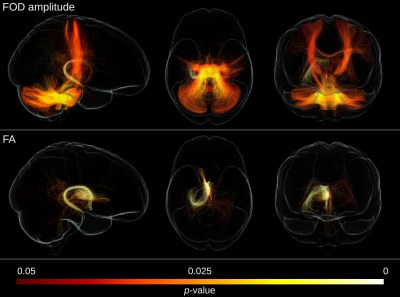 |
4781. Streamline-Based
Analysis: A novel framework for tractogram-driven
streamline-wise statistical analysis
S. Zanoni, J. Lv, R. Smith, F. Calamante
The University of Sydney, Sydney, Australia
Impact: The introduced SBA method offers an
unprecedented streamline-wise specificity and an unexplored
perspective for investigating brain differences, where the
pathways of the streamlines effectively shape the insights
gained from imaging data across different modalities.
|
|
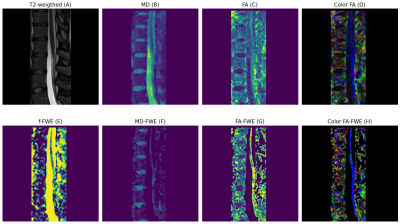 |
4782. Free-Water
Elimination (FWE) reduces partial volume effects from
cerebrospinal fluid in DTI of the human spinal cord
A. Blombäck, M. Ljungberg, H. Olsson, K. Lagerstrand
Institute of Clinical sciences, Sahlgrenska Academy, University of Gothenburg, Gothenburg, Sweden
Impact: Findings display reduced partial volume effects
in diffusion tensor imaging of spinal cord with the use of
free-water elimination. Potentially facilitating more
accurate assessment of microstructural changes and
surveillance of patients with spinal cord affection.
|
|
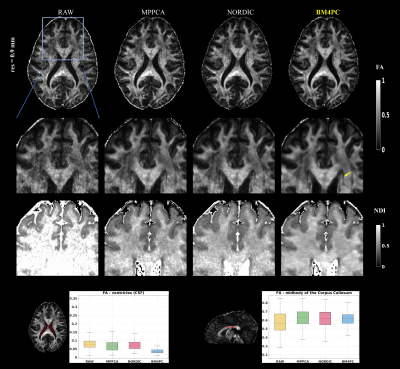 |
4783. Denoising
diffusion MRI data: Principal components meet non-local
block-matching
V. Campos, D. Szczupak, T. Santini, A. Silva, A. Foi, M.
Vieira, C. Baron
University of PIttsburgh, Pittsburgh, United States
Impact:
The innovative BM4PC reduces noise in diffusion-weighted images, enabling diagnostic capabilities and sensitivity to tissue microstructure and degeneration. It can be applied across diverse acquisition types and datasets (in vivo and ex vivo), from Cartesian encoding to advanced spiral techniques. |
|
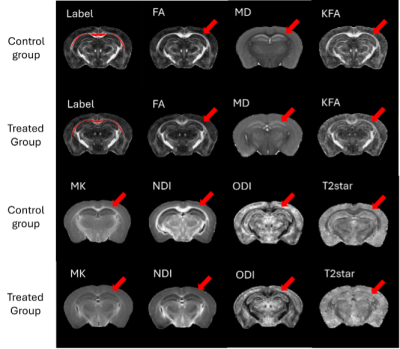 |
4784. Architectural
Disruption Signature: Region-specific MRI Biomarkers in
Cuprizone-induced Demyelination for Alzheimer’s Disease
Z. Liu, P. Eddula, M. Jafry, J. Chen, N. Wang
UT Southwestern Medical Center, Dallas, United States
Impact: This comprehensive multi-modal MRI analysis
provides insight into region-specific pathological changes
in the cuprizone model, particularly in isocortex and
hippocampal areas. These findings enhance our understanding
of demyelination processes and could guide the development
of targeted therapeutic strategies for AD.
|
|
 |
4785. GPU-accelerated
Diffusion MRI Tractography in DIPY
J. Kruper, M. Bisson, J. Romero, M. Fatica, A. Rokem
University of Washington, Seattle, United States
Impact: We introduce GPU-accelerated tractography that
achieves up to 50x faster performance per GPU. Through
integration with the Diffusion Imaging in Python (DIPY)
library, it enables large-scale tractography studies that
would not be possible otherwise.
|
|
 |
4786. A
Deep Diffusion Model Approach for Diffusion MRI White Matter
Fiber Tractography
Y. Li, W. Zhang, X. Zhu, Y. Wu, Y. Rathi, L. O’Donnell, F.
Zhang
University of Electronic Science and Technology of China, Chengdu, China
Impact: The proposed diffusion model-based method,
integrating local neighborhood information and sequential
dependencies, directly achieves local fiber orientation
estimation and tractography. Tested on in silico and in vivo
datasets, we demonstrate competitive performance against
current methods.
|
|
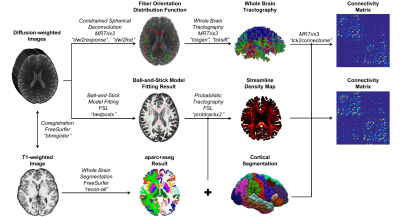 |
4787. Impacts
of diffusion MRI spatial resolutionon on the short-range
association fiber reconstruction and connectivity estimation
J. Zheng, C. Yang, W. Zhong, Z. Wang, H. Li, Z. Li, M. Liu,
H. Yang, X. Cao, C. Liao, D. Salat, S. Huang, Q. Tian
Tsinghua University, Beijing, China
Impact:
This study demonstrates the poor reconstruction result of SAFs at low resolution, emphasizing the need for high-resolution diffusion imaging for accurately SAF modeling. The gSlider protocol presented in the study could be an ideal choice for SAFs research. |
|
 |
4788. Improving
Specificity in Fixel-Based Analysis
H. Rafipoor, S. Jbabdi, L. Concha, M. Cottaar
University of Oxford, Oxford, United Kingdom
Impact: This study improves the specificity of
fixel-based analysis in diffusion MRI, allowing for more
accurate detection of fiber-specific microstructural
changes. It paves the way for tract-specific metrics that
could enhance the diagnosis of neurological conditions with
selective fibre degeneration.
|
|
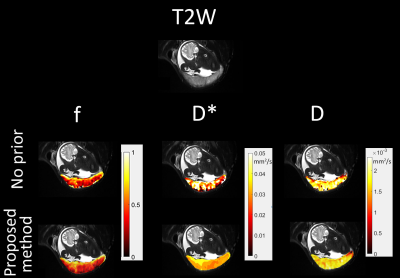 |
4789. Measuring
Perfusion in normal and pathological placentas using an advanced
IVIM method.
N. Elsaid, H. Tagare, J. Ngwa, K. Kapse, C. Limperopoulos,
N. Andescavage
Children’s National Health System, Washington, United States
Impact: To better understand and analyze in-vivo
placental perfusion, we developed a novel method based on
mixture-prior for intravoxel incoherent motion (IVIM). It
shows an improved ability to distinguish between control and
growth-restricted placentas.
|
|
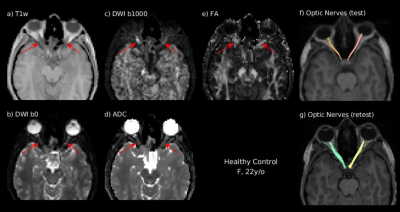 |
4790. Diffusion
Tensor Imaging as a Methodology for Optic Nerve Evaluation
K. Clarke, Z. Ben Youss, P. Filipiak, A. Verdone Sanchez, M.
Bruno, V. Dedania, K. Chan, S. Baete
NYU Langone Health , New York, United States
Impact: Non-invasive optic nerve screening with DTI may
provide additional insight into the optic nerve
microstructure making it a potential avenue to identify
optic neuropathies, such as glaucoma.
|
|
 |
4791. Linking
brain and eye fluid dynamics: Multi-b-value diffusion derived
interstitial fluid volume relates to tear fluid AQP5 levels
B. van den Heuvel, N. van de Sande, G. Drenthen, W. Backes,
M. Gijs, J. Jansen, M. van der Thiel
Maastricht University Medical Center, Maastricht, Netherlands
Impact: By identifying a relationship between tear fluid
AQP5 concentration and cerebral interstitial fluid volume,
this study suggests that eye and brain fluid dynamics are
linked, supporting the hypothesized link between ocular and
brain (glymphatic) clearance in humans.
|
|
 |
4792. Creatinine
accumulation may lead to increased interstitial fluid in
patients with chronic kidney disease
W. Yang, L. Song, M. Li, X. Bai, B. Xu, H. Wang, Z. Wang
Department of Radiology, Beijing Friendship Hospital, Capital Medical University , Beijing, China
Impact: A novel approach to measure ISF shows the
potential for detecting brain glymphatic system function,
which provides unique insights into the pathological
mechanisms underlying cognitive decline in CKD patients.
|
|
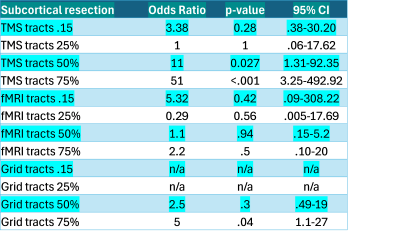 |
4793. Towards
Data-Driven Tractography for Surgical Planning
M. Muir, K. Noll, V. Kumar, S. Prabhu, R. Stafford, B.
Taylor
MD Anderson Cancer Center, Houston, United States
Impact: These findings outline a data-driven,
patient-specific approach for using tractography to localize
the language-essential regions surrounding the tumor.
|
|
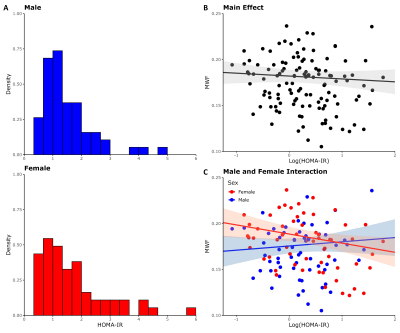 |
4794. Higher
Insulin Resistance is Associated with Lower Myelin Content in
Women
N. Zhang, Z. Gong, J. Bae, A. Guo, N. Fox, A. De Rouen, J.
Laporte, M. Bouhrara
National Institutes of Health, Baltimore, United States
Impact: This research highlights the connection between
metabolic conditions and white matter integrity in women. It
also underscores that MWF offers a more sensitive measure of
microstructural differences as compared to FA.
|
|
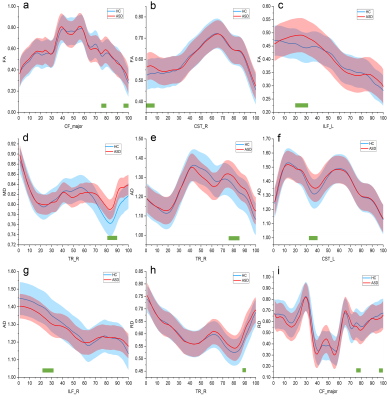 |
4795. White
Matter Integrity and Asymmetry Alterations in Young Children
with Autism Spectrum Disorder: An Automated Fiber Quantification
Study
D. Luo, C. Zhao, L. Nie, Y. Yin, X. Liu, H. Yu, F. Wang, H.
Chen, H. Liu
Department of Radiology, Affiliated Hospital of Zunyi Medical University, Engineering Research Center of Intelligent Medical Imaging in Guizhou Higher Education Institutions, 149 Dalian Road, Huichuan District, Zunyi, Guizhou 563003, P.R. China, Zunyi, China
Impact: This study identifies WM biomarkers linked to
social and repetitive behaviors in ASD, guiding early
diagnosis and intervention. These findings pave the way for
research on targeted treatments addressing specific
neurodevelopmental delays in ASD.
|
|
 |
4796. DTI-ALPS
mapping: A Novel Method for Analyzing the Glymphatic System in
the Brain
X. Zhang, X. Fan, K. Yu, Q. Li, X. Li, Y. Qi, L. Chen, Z.
Wei, G. Lu, H. Chen, L. Hu, G. Cheng, N. Zhang
Paul C. Lauterbur Research Center for Biomedical Imaging, Shenzhen Institute of Advanced Technology, Chinese Academy of Sciences, Shenzhen, China
Impact: This study represents a pioneering effort by
introducing a white matter DTI-ALPS mapping technique. This
innovative approach significantly enhances the detection of
differences associated with cognitive decline and offers a
more comprehensive perspective for advancing our
understanding of neurodegenerative processes.
|
|
 |
4797. Cardiac
Magnetic Resonance T1 Mapping Combined with Myocardial Diffusion
Technique for Evaluating Fibrosis in Hypertensive Heart Disease
(HHD)
X. Ruan, X. Yue
Ningxia Hui Autonomous Region People's Hospital, Ningxia,yinchuan, China
Impact: This study provides a quantitative assessment of
myocardial fibrosis in HHD patients using T1 mapping
combined with MoCo cDWI, supporting fibrosis diagnosis.
|
|
 |
4798. Increased
Brain white matter extracellular free-water is associated with
memory function in ESRD patients
H. J. Chen, J. Qiu, Y. Qi, Y. Guo, W. Huang, H. Qin, F. Wu,
F. Chen
Hainan General Hospital (Hainan Affiliated Hospital of Hainan Medical University), Haikou, China
Impact: This study highlights a potential link between
elevated extracellular free water in white matter and memory
decline in hemodialysis patients, suggesting
neuroinflammation or microvascular impairment. These
findings could inform future research on neuroprotective
strategies in dialysis patients.
|
|
 |
4799. Comparison
of MoCo-MPG schemes and readout sequences (EPI/TSE) towards
robust myocardial IVIM-DWI
Y. Goto, M. Nagao, M. Yoneyama, G. Gilbert, J. Peeters, I.
Shiina, Y. Katsumata, K. Kodaira, Y. Hamatani, M. Kato, S.
Sakai
Tokyo Women's Medical University Hospital, Tokyo, Japan
Impact: Cardiac IVIM may play an important role in the
evaluation of various cardiac diseases.Our results suggest
that M2-null EPI-DWI using deep learning-constrained
compressed SENSE with high reduction factor may be a
suitable method for robust myocardial IVIM imaging.
|
The International Society for Magnetic Resonance in Medicine is accredited by the Accreditation Council for Continuing Medical Education to provide continuing medical education for physicians.